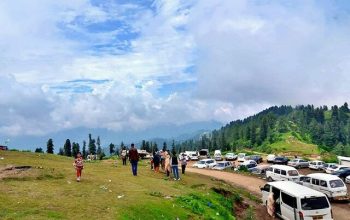Pakistan and China are celebrating 10 years of successful execution of the China-Pakistan Economic Corridor (CPEC). There is no second opinion among Pakistanis that CPEC has benefited the country immensely.
CPEC has helped to overcome challenges like electricity shortage, rehabilitation and construction of transport infrastructure, alternative seaports, etc.
However, the opponents do not accept the reality and question the importance of CPEC. They try to tag CPEC with problems like debt trap by ignoring the opportunity cost of no-CPEC.
A quick analysis by the Asian Institute of Eco-civilisation Research and Development indicates that the opportunity cost of no-CPEC would be very high.
Let’s start with the energy sector. A deep dive into facts portrays a scary picture without CPEC projects. The analysis indicates that before the launch of CPEC, Pakistan was facing an acute shortage of electricity. The industry had started shifting from the country as business opportunities were shrinking.
There were limited opportunities to create jobs for the growing young population. These inflicted a heavy cost on the economy and according to government statistics, the country was losing $4-5 billion annually.
It did not include health costs as people were suffering from sleeplessness due to prolonged electricity load-shedding. CPEC energy projects helped to manage, if not overcome, the challenge of electricity outages. Owing to new power projects, per capita consumption of electricity improved from 431 kilowatt-hours (kWh) in 2014 to 644 kWh in 2022.
Now imagine a scenario, if CPEC energy projects had not been made operational, then what would have been the cost of electricity load-shedding? A rough estimate shows the annual loss would have been around $15-20 billion due to power outages. How?
There are two major factors which support the argument. First, in 2014 the total population of Pakistan was 188 million, which continued to increase over the last eight years.
According to the new population census, the total population was 241 million in 2022. It means that due to the increase in population, the demand for energy rose substantially.
Second, the per capita consumption of electricity increased during the same period. Both scenarios indicate that the demand expanded during the given timeframe.
That means in 2023 Pakistan may have suffered the worst load-shedding, leading to de-industrialisation, unemployment, mental health issues and closure of businesses. In a nutshell, the cost would have increased to $15-20 billion.
Let’s try to study the impact while keeping in mind the present economic crisis. Pakistan is struggling to find means to avert debt risks and reignite growth. In this scenario, the International Monetary Fund (IMF) has forced the country to accept all its conditions to get a loan of $3 billion.
Apart from reducing the energy shortfall, CPEC has helped to tackle poverty via three types of interventions. First, it created jobs and decent livelihood opportunities. According to data, 192,000 jobs were created during the first phase.
Second, more than 100 small and medium enterprises (SMEs) benefited from CPEC projects, which created indirect jobs and provided support to many families. Third, CPEC provided electricity to industries and a better transport infrastructure. It is certain that in the absence of CPEC, the poverty level would have increased.
Roads and highways
In 2014, Pakistan needed $1.2 billion to rehabilitate the national road infrastructure, which had deteriorated due to the transit facility provided to the NATO supply chain.
Pakistan was scouting for investment to rehabilitate the infrastructure, but its allies did not show any interest. At that time, China came forward and helped not only rehabilitate infrastructure but also provided capital and expertise for new infrastructure projects.
According to statistics, under CPEC, 851 km of new motorways were constructed, which improved connectivity and attracted new investment into the country.
Youth training
In addition to this, it is a common fact that Pakistan is blessed with a youth bulge. To capitalise on the opportunity, it needs to equip them with proper skills.
Unfortunately, there are not enough resources to provide skills development opportunities to the youth. In this case too, China’s government provided millions of dollars for skills development under CPEC. Besides, Chinese companies also imparted training to the youth. According to the available data, Huaneng Shandong Rui Group, which had built the Sahiwal coal-based power plant, invested in building the capacity and sharpening the skills of its 622 employees.
Further data breakdown shows that 245 engineers were trained in accordance with the needs of the plant. Moreover, Huaneng Shandong Rui Group plant administration built the capacity of 377 general staff members.
Port Qasim also contributed to building the capacity of engineers and staff members. Data shows that 2,600 employees benefited from the capacity building and skills development opportunities offered by the Port Qasim plant.
It trained 600 engineers and 2,000 general staff members, which was a huge number, especially in the engineering category.
Critical investment
In 2014-15, Pakistan was under the worst attack of terrorism as it was paying the price of being the frontline ally. It suffered economic losses of more than $100 billion and lost almost 50,000 human lives in terrorism incidents. At that time, the allies declared Pakistan an unsafe destination for investors.
Pakistan was struggling to look for investment opportunities. Unfortunately, no one was interested in investing in the country; even the Pakistani business community was hesitant. At that critical time, China joined hands with Pakistan to launch CPEC, which also paved the way for investment from other sources. Now, many countries are showing interest in joining CPEC including the Central Asian States, Asean members, etc.
From the above discussion, it can be inferred that the opportunity cost of no-CPEC is very high. In its absence, the economic and social situation would have been in a bad shape as the West may be pushing Pakistan to toe its line.
Thus, it is a general consensus among Pakistanis that CPEC has helped the country to avoid such a situation.
The writer is a political economist and a visiting research fellow at Hebei University, China
Published in The Express Tribune, August 21st, 2023.
Like Business on Facebook, follow @TribuneBiz on Twitter to stay informed and join in the conversation.
Read the full story at the express tribune website.


